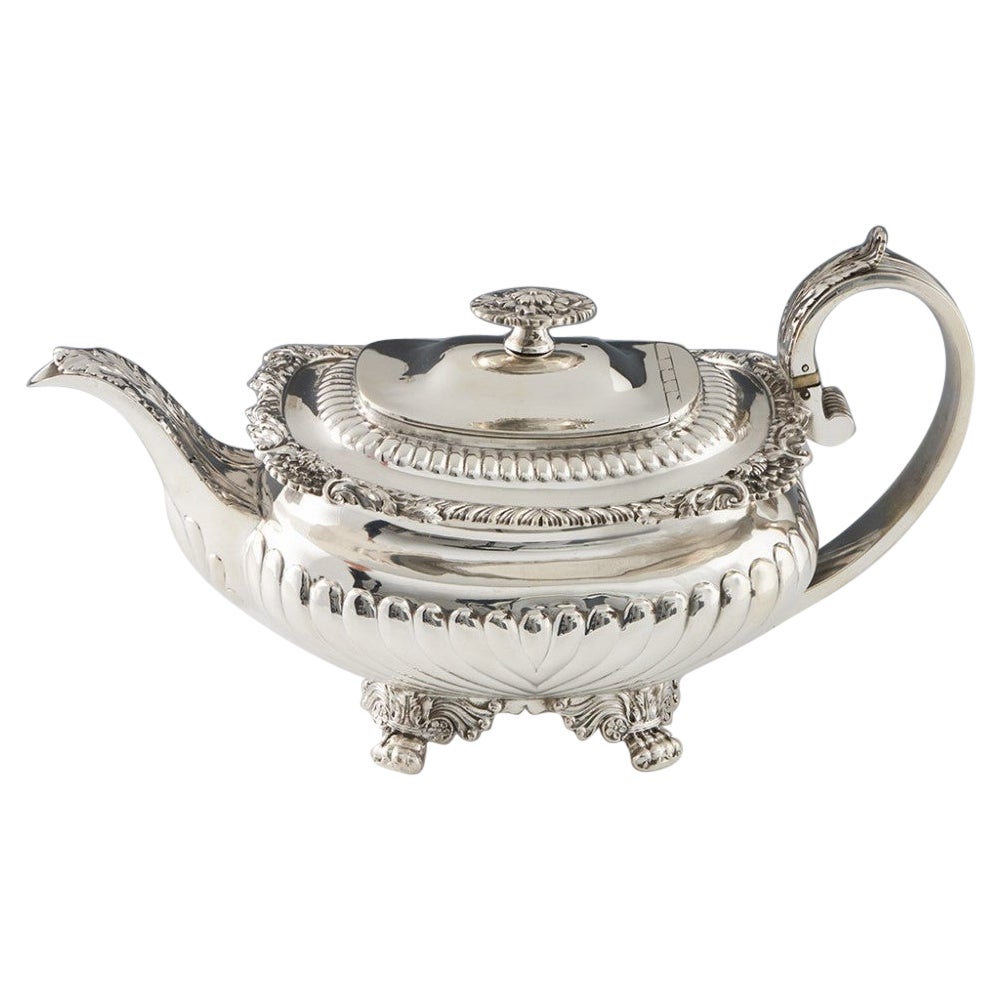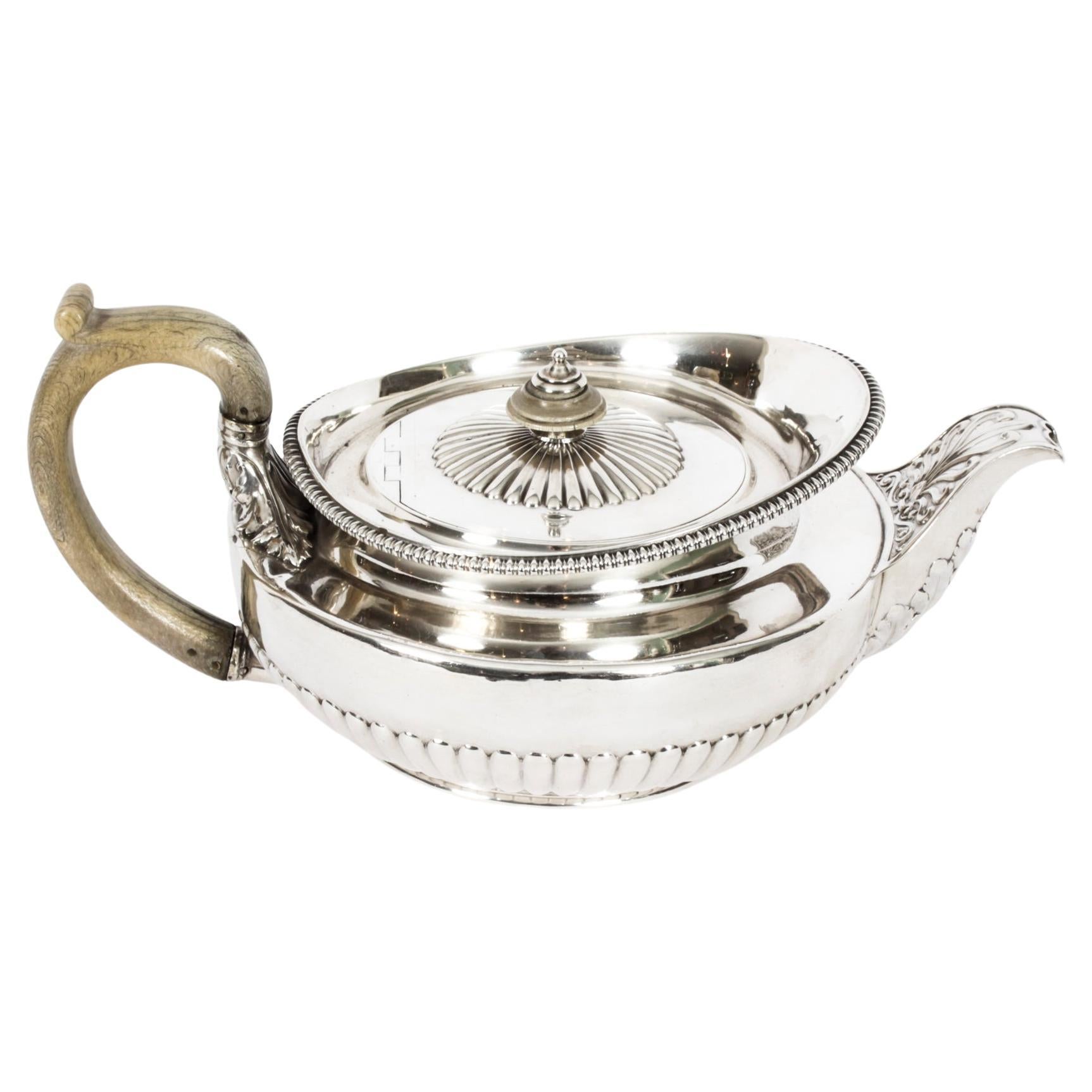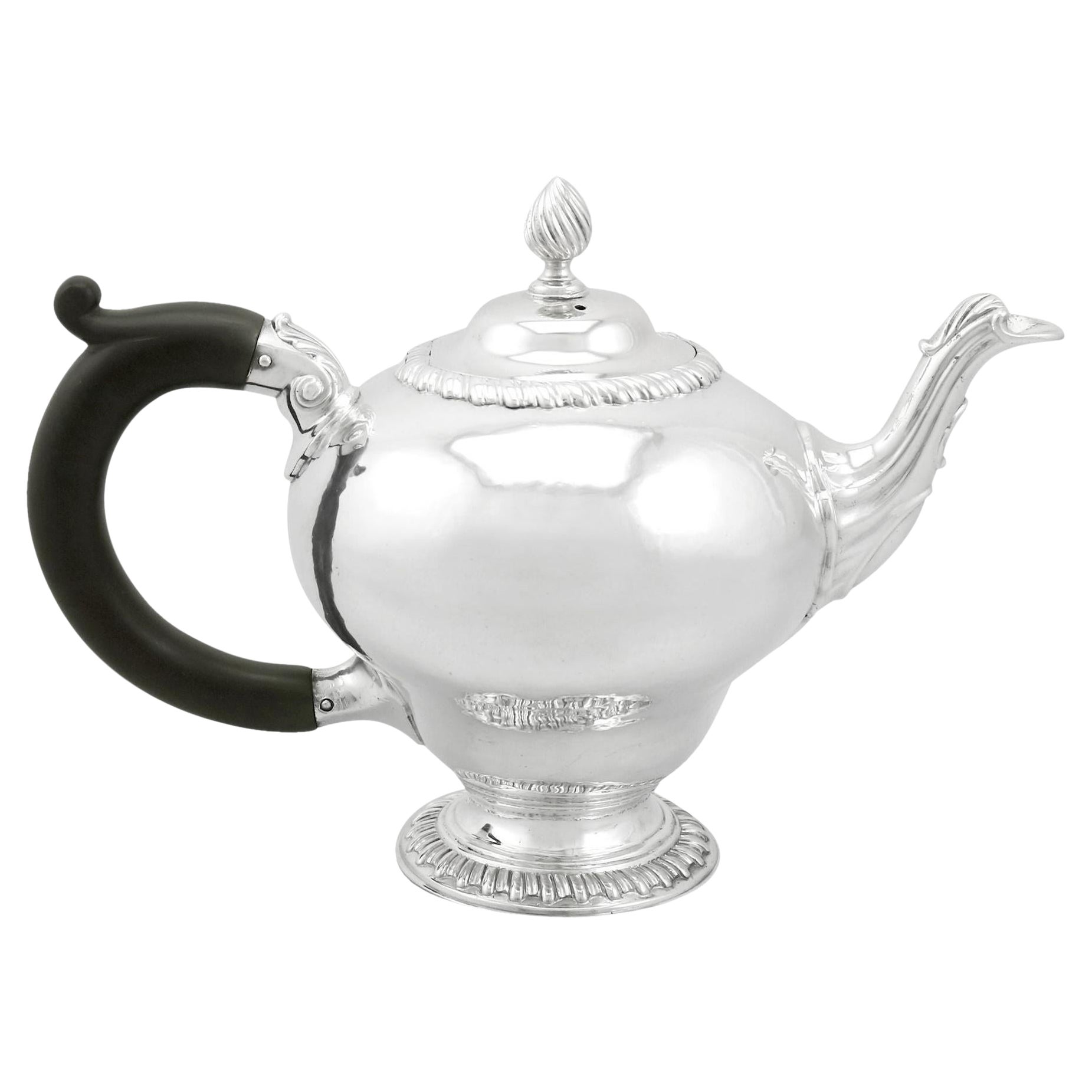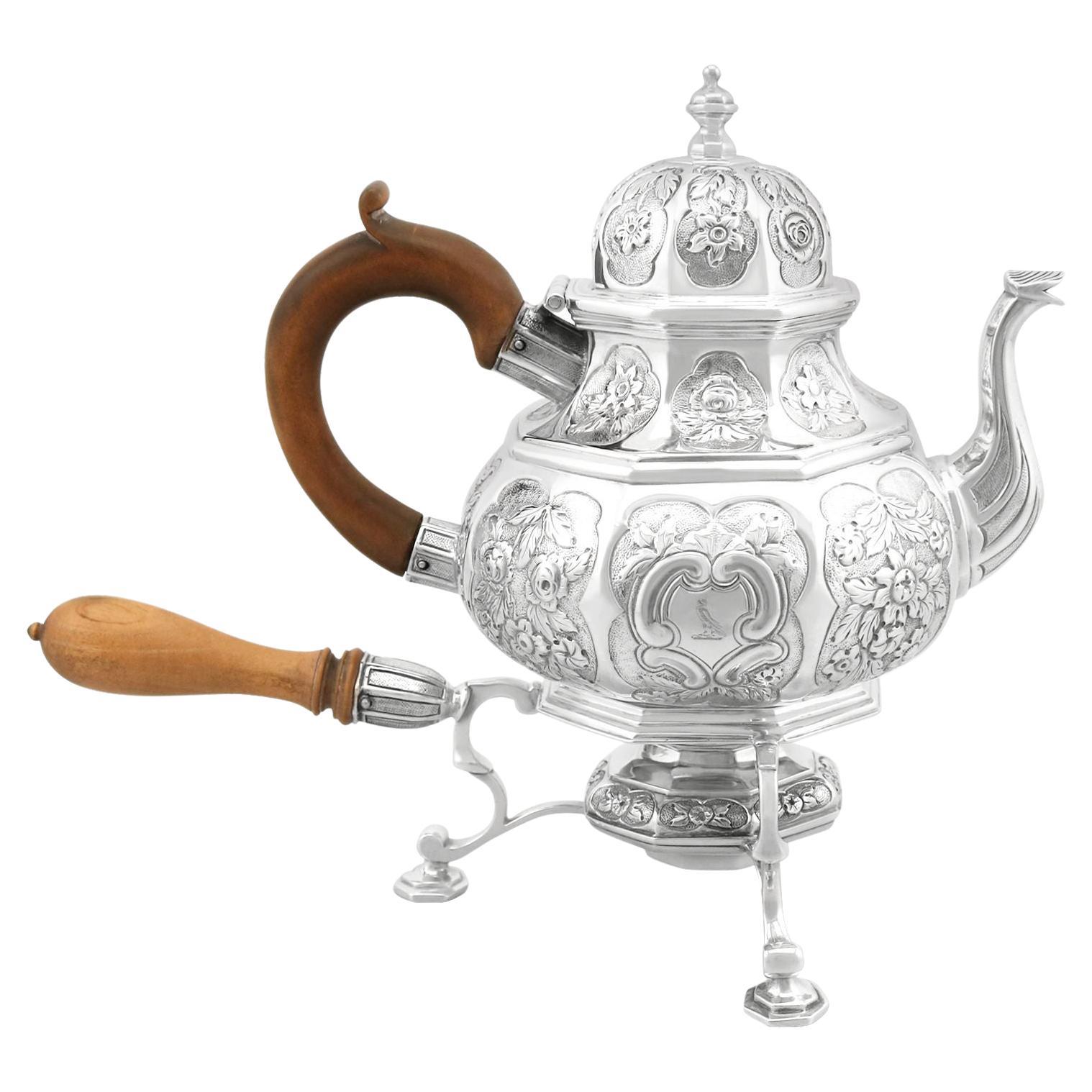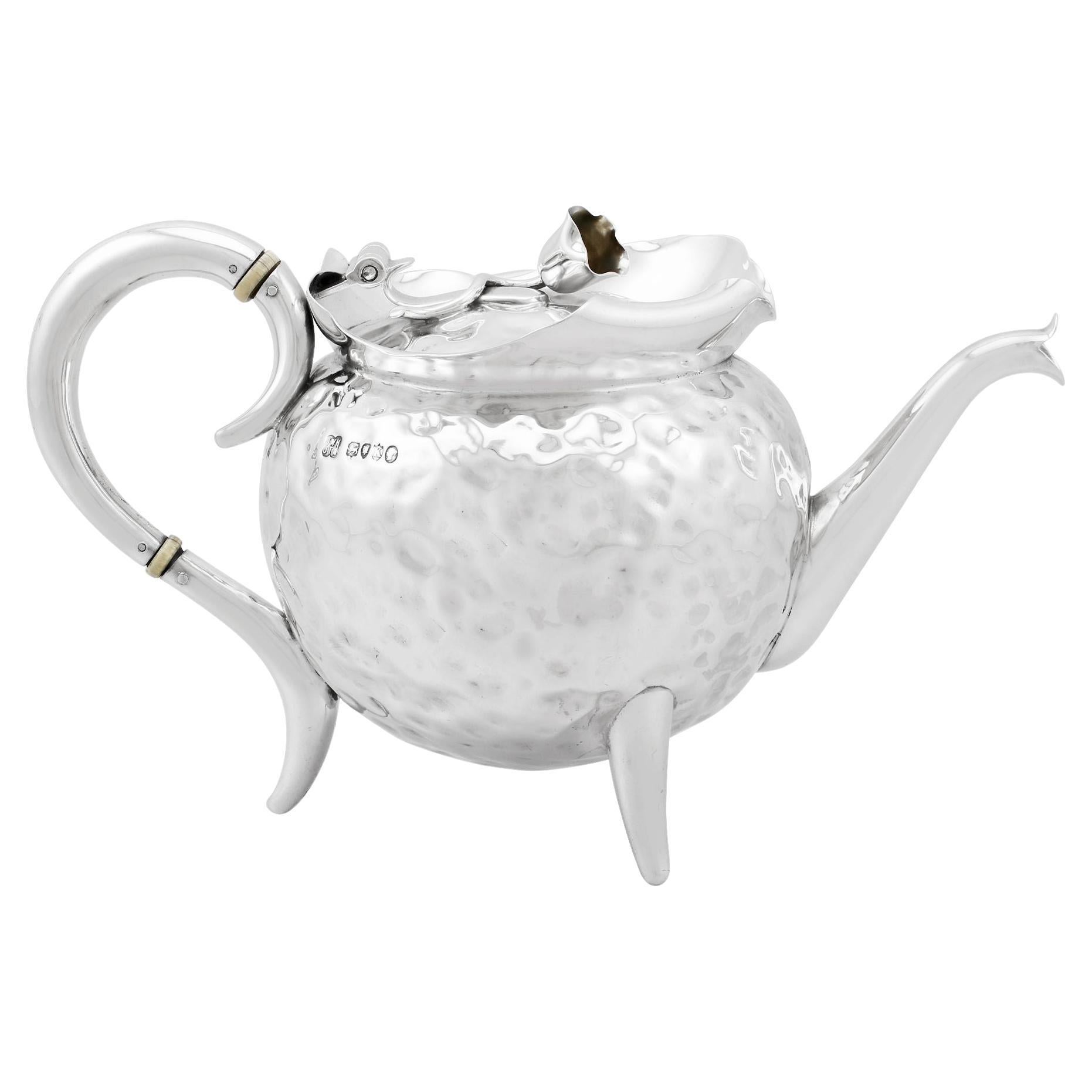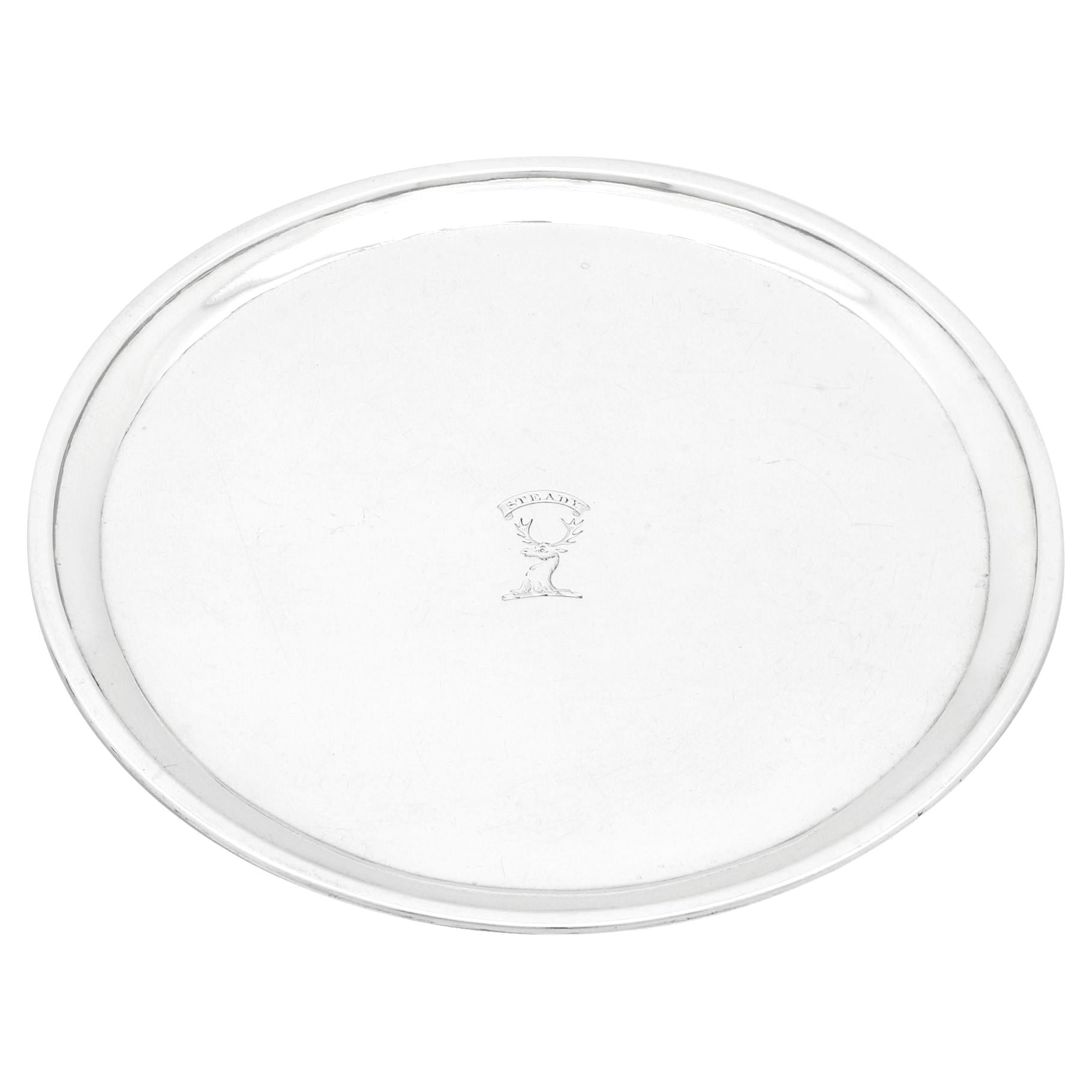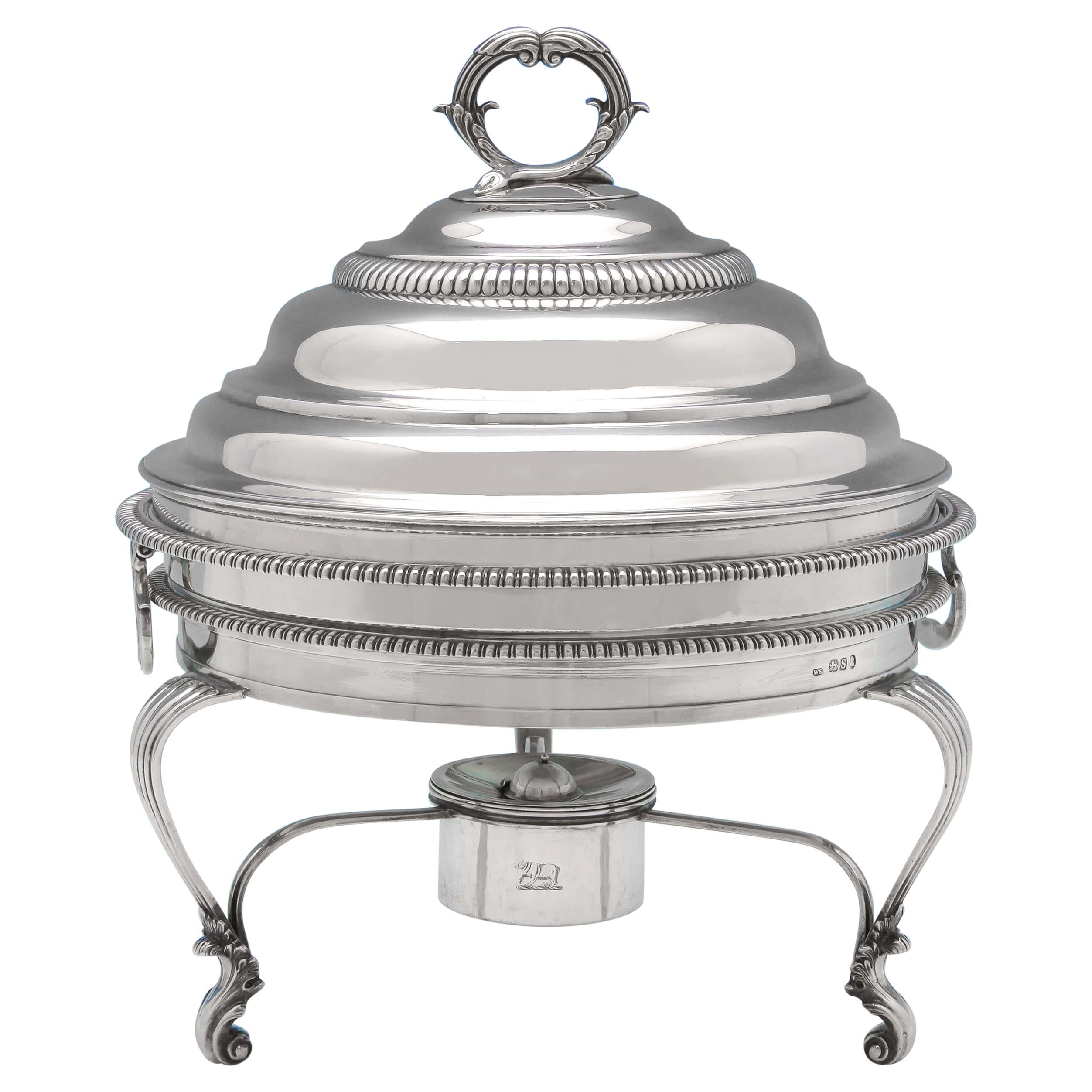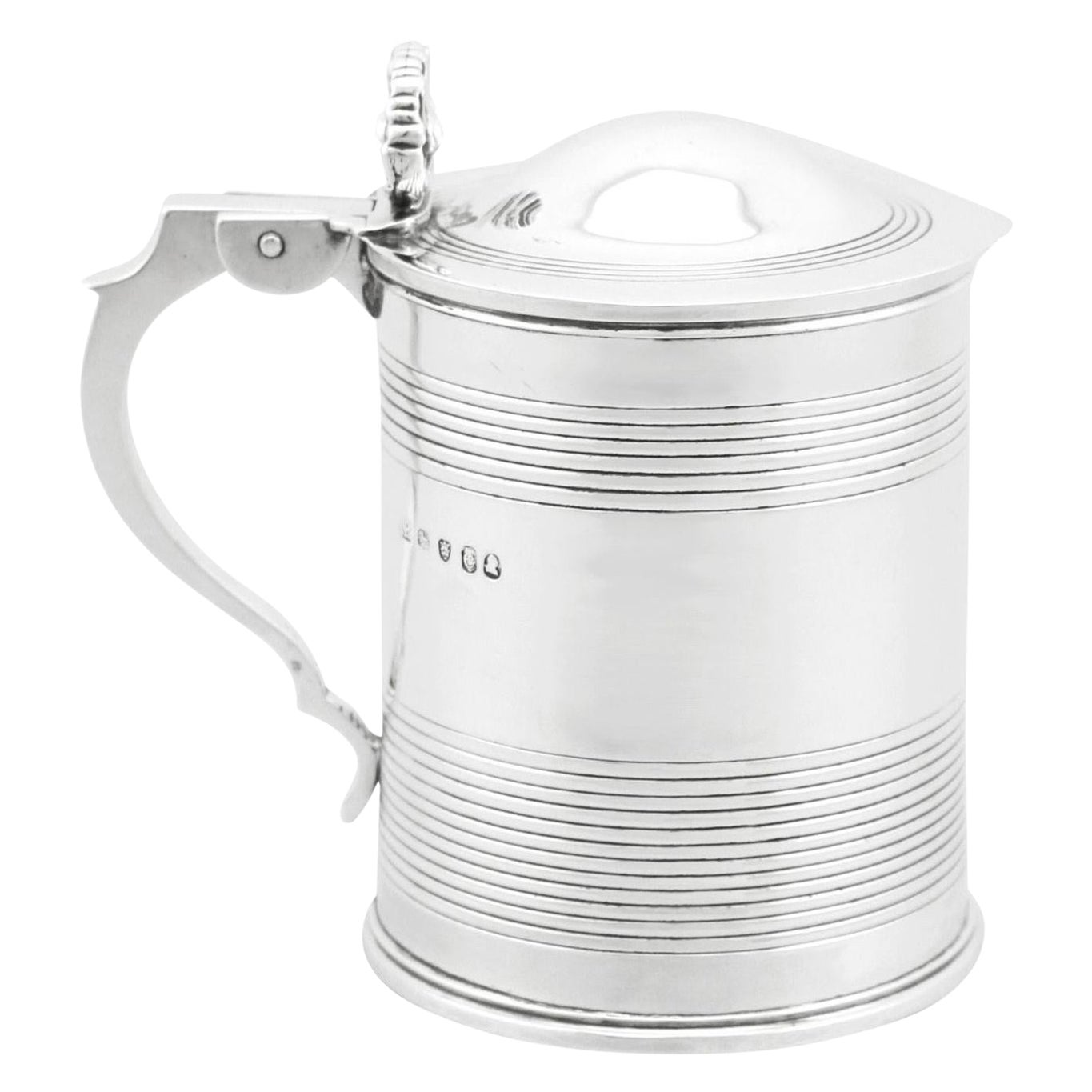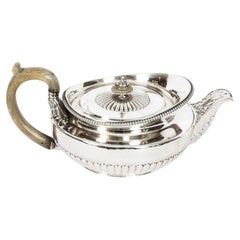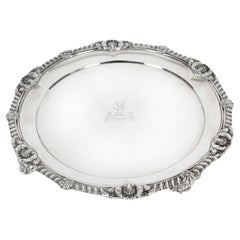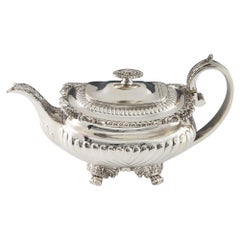
Antique Regency Sterling Silver Teapot Craddock & Reid 1820 19th C
View Similar Items
Want more images or videos?
Request additional images or videos from the seller
1 of 19
Antique Regency Sterling Silver Teapot Craddock & Reid 1820 19th C
About the Item
- Dimensions:Height: 5.91 in (15 cm)Width: 11.82 in (30 cm)Depth: 6.7 in (17 cm)
- Style:George III (Of the Period)
- Materials and Techniques:
- Place of Origin:
- Period:
- Date of Manufacture:1820
- Condition:
- Seller Location:London, GB
- Reference Number:Seller: A25191stDibs: LU950627324622
About the Seller
5.0
Platinum Seller
These expertly vetted sellers are 1stDibs' most experienced sellers and are rated highest by our customers.
Established in 1983
1stDibs seller since 2012
1,204 sales on 1stDibs
Typical response time: 1 hour
Associations
LAPADA - The Association of Arts & Antiques Dealers
More From This SellerView All
- Antique Rare Georgian Sterling Silver Teapot by Paul Storr 1817, 19th CenturyBy Paul StorrLocated in London, GBThis is an exceptional and very rare antique English George III sterling silver teapot by the world-famous silversmith, Paul Storr, and bearing hallmarks for 1817. This splendid teapot is of a delightful shape and it is profusely chased with half ribbed fluting decoration. It is further embellished with wonderful foliate motifs below and above the spout and stunning gadrooned shaped borders to the top of the teapot and the base. The remarkable quality flush hinged lid is also beautifully surmounted by a delightful round finial. It features an exceptional horn handle with striking details, proving the silversmith's exceptional mastery in the creation of unique and luxurious silverware - Paul Storr never tired of adding detail to create a true piece of artwork. The underside of the teapot bear full hallmarks: the Lion passant for sterling silver, the leopard head for London, the letter for 1817 and the maker's marks 'PS' for Paul Storr. There is no mistaking its unique quality and design, which is sure to make it a treasured piece by any discerning collector. Condition: In excellent condition with clear hallmarks and no dings, dents or signs of repair. Please see photos for confirmation. Dimensions in cm: height 12.5 x width 18 x depth 18 Weight 0.88 kg Dimensions in inches: height 5 inches x width 7 inches x depth 7 inches Weight 28.2 troy oz Paul Storr born in London England in 1771, was to become one of the most talented silversmiths of the nineteenth century. Today his legacy of exceptionally well crafted silver, found worldwide in museums and private collections, leaves one in awe when compared to that of his contemporaries.After having served a seven year apprenticeship from the age of 14, he began his career in 1792 when he went into a brief partnership with William Frisbee. This did not last and in 1793 a new mark, (his initials ‘P S’) was entered. By the beginning of the nineteenth century he had established himself as one of London’s top silversmiths producing, amongst others, commissions for Royalty. In 1801 he married Elizabeth Susanna Beyer with whom he was to have ten children. In 1807 Paul Storr entered into a working relationship with Philip Rundell and by 1811 was a partner, and managing the workshops for Rundell, Bridge & Rundell. During this period he kept his own marks and separate workshop. However it was through Rundell, Bridge & Rundell who were appointed Goldsmith in Ordinary to George III in 1804 that his reputation as a master silversmith grew. His talents lay in being able to transform ideas and designs from Rundell, Bridge & Rundell’s designers, William Theed...Category
Antique 1810s English George III Sterling Silver
MaterialsSterling Silver
- Antique George III Sterling Silver Salver by Paul Storr 1811 19th CenturyBy Paul StorrLocated in London, GBThis is a wonderful English antique George III sterling silver 10 inch salver, by the world famous silversmith Paul Storr. It has clear hallmarks for London 1811 and the makers mark of Paul Storr. It is typical of his work with the raised gadrooned rim with anthemion at intervals, on four fabulous foliate bracket feet. The salver is engraved with a crest and motto and the underside is later engraved Charlotte J. Parke from C. J. Parke, March 1893' The centre is engraved with a crest above a motto 'True and Fast' and I have researched this crest: The Crest of Parke The crest as engraved upon this George III English Sterling Silver Footed Salver by Paul Storr hallmarked London 1811 is that of the family of Parke. It may be blazoned as follows: Crest: A stag’s head couped sable holding in the mouth a key or Motto: True and fast The family of Parke originally hailed from the County of Cumberland in the northeast of England1 later settling in the County of Dorset at Henbury House, Sturminster Marshal, near Wimborne. Given the evidence of the inscription found on the underside of the salver ‘Charlotte J. Parke from C. J. Parke, March 1893’ it was undoubtedly at one time in the possession of Charles Joseph Parke (died 9th March 1893) of Henbury House aforesaid and gifted to Charlotte Josephine Parke (baptised 4th January 1857 died 2nd January 1941) his third daughter by his wife, Ellen Mary Ethelston. I would venture the following hypothesis that the salver was bequeathed to Charlotte in her father’s will that was granted probate at London on the 20th May 1893. The ‘March 1893’ of the inscription acts as a remembrance of the month of the death of her father. It was noted that Charlotte’s father left an estate worth some £66,892, 19 shillings and one pence, a very considerable sum in the last decade of the 19th Century and even thereafter. Charlotte never married and was living at the time of her death at The Coppice, Sixpenny Handley in the County of Dorset. Her will was proved for probate at Llandudno on the 25th March 1941. She left an estate worth £18,866, 10 shillings and 4 pence. Again, a comfortable sum in 1941. See the photo of Henbury House, Sturminster Marshal, near Wimborne, Co. Dorset. The former seat of the Parke family. The house was destroyed by fire, the remains of which were demolished in the 1990's. There is no mistaking its unique quality and design, which is sure to make it a treasured piece by any discerning collector. Condition: In excellent condition with clear hallmarks and no dings, dents or signs of repair. Please see photos for confirmation. Dimensions in cm: Height 2 x Width 26.5 x Depth 26.5 Weight 0.69 kg Dimensions in inches: Height 1 inch x Width 10 inches x Depth 10 inches Weight 1.5 lbs Paul Storr born in London England in 1771, was to become one of the most talented silversmiths of the nineteenth century. Today his legacy of exceptionally well crafted silver, found worldwide in museums and private collections, leaves one in awe when compared to that of his contemporaries.After having served a seven year apprenticeship from the age of 14, he began his career in 1792 when he went into a brief partnership with William Frisbee. This did not last and in 1793 a new mark, (his initials ‘P S’) was entered. By the beginning of the nineteenth century he had established himself as one of London’s top silversmiths producing, amongst others, commissions for Royalty. In 1801 he married Elizabeth Susanna Beyer with whom he was to have ten children. In 1807 Paul Storr entered into a working relationship with Philip Rundell and by 1811 was a partner, and managing the workshops for Rundell, Bridge & Rundell. During this period he kept his own marks and separate workshop. However it was through Rundell, Bridge & Rundell who were appointed Goldsmith in Ordinary to George III in 1804 that his reputation as a master silversmith grew. His talents lay in being able to transform ideas and designs from Rundell, Bridge & Rundell’s designers, William Theed...Category
Antique 1810s English George III Sterling Silver
MaterialsSterling Silver
- Antique Sterling Silver Punch Bowl Walter Barnard 1892 19th CLocated in London, GBThis is a large gorgeous antique Victorian sterling silver punch bowl bearing the makers mark of the renowned silversmith Walter Barnard with hallmarks forLondon 1892 and retailed by Gibson & Co, Belfast. This exquisite punch bowl is also ideal as a champagne cooler and it has beautiful and incredibly detailed embossed half fluted decoration and is raised on a pedestal foot. It bears a fabulous heraldic crest for the Sharman-Crawford family with the latin motto "Durum Patientia Frango" which translates to "By patience I break what is hard" The SHARMAN-CRAWFORD combined Coat of Arms Born at Moira Castle, at the age of 25 on 5 December 1805, as William SHARMAN, he married at Bangor, Mabel Fridiswid CRAWFORD and had with her eleven children. They lived together at Crawford House, Crawford's Burn, Co. Down, Northern Ireland. Just before his death in 1827, William's brother-in-law Arthur Crawford in a pact with his father, agreed to break the entail on the estate in favour of his sister Mabel Fridiswid CRAWFORD, and William SHARMAN was authorised, by Royal Licence to assume the surname of CRAWFORD in addition to, and after SHARMAN, and to bear the arms of Crawford quarterly with those of Sharman, thus beginning the SHARMAN-CRAWFORD line. This is truly a special item and it will attract the maximum amount of attention, the quality and craftsmanship are undeniable. Condition: In excellent condition with clear hallmarks and no dings, dents or signs of repair. Please see photos for confirmation. Dimensions in cm: Height 19 x Width 35 x Depth 35 Weight 1.84 kg Dimensions in inches: Height 7 inches x Width 1 foot, 2 inches x Depth 1 foot, 2 inches Weight 59 troy oz Walter Barnard (1868 - 1903) was part of possibly the oldest manufacturing silversmith in the world, the origin of this business having been established by Anthony Nelme...Category
Antique 1890s British Victorian Sterling Silver
MaterialsSterling Silver
- Antique Large William IV Silver Tray Salver by Paul Storr 1820 19th CenturyBy Paul StorrLocated in London, GBThis is a wonderful English antique William IV sterling silver tray, or salver, by the world famous silversmith Paul Storr. It has clear hallmarks for London 1820 the makers mark of Paul Storr. It is typical of his work with the octafoil shape and the exquisitely detailed reeded rim, and it is raised on four delightful foliate and scroll feet. The centre is engraved with a shield shaped coat of arms which I have had researched. The Marital Arms of Knollis and Hallifax The armorial bearings as engraved upon this George IV Large English Sterling Silver Footed Salver by Paul Storr hallmarked London 1820 are those of the family of Knollis with Hallifax in pretence. These armorial bearings denote the marshalling of a marital coat showing the arms of the husband over the entire surface of the shield, whilst the arms of the wife (as an heraldic heiress) are placed on a small shield (known as an escutcheon of pretence) centrally on the husband’s arms. They may be blazoned as follows: Arms: Quarterly 1st and 4th Azure crusily of cross crosslets a cross moline voided or (for Knollys) 2nd and 3rd Gules on a chevron argent three roses of the field barbed proper (for Knollys) over all an escutcheon of pretence Or on a pile engrailed sable between two fountains barry wavy of six argent and azure three cross crosslets of the first (for Hallifax) Crest: An elephant argent [differenced with a mullet1 ] (for Knollys) Motto: In utrumque paratus [Prepared for either] (for Knollys) These armorial bearings undoubtedly commemorate the marriage of The Honourable and Reverend Francis Knollis2 (baptised 3rd January 1743 died 27th February 1826), 1 The cadency mark for a third son of a family. 2 Francis appears to have preferred this spelling of his family’s surname. It is spelt as it is to be pronounced. of Burford in the County of Oxfordshire and of Eastleach Martin in the County of Gloucestershire and Mary Hallifax (baptised 5th March 1753 buried 18th December 1830). Francis and Mary were married at the Parish Church of St Mary, Ewell in the County of Surrey on the 9th June 1772. Francis was the third son of Charles Knollys (the titular 5th Earl of Banbury) 3 and his wife, Martha Hughes, whilst Mary was the daughter of The Reverend James Hallifax, of Ewell aforesaid and his wife, Elizabeth Chardavoyn. 3 Francis’s father claimed to be the 5th Earl of Banbury. A claim that continued to be pursued by the family until William Knollys, the titular 8th Earl of Banbury (born 1763 died 1834) was forced to discontinue its use by a resolution of the House of Lords which rejected his claim to the earldom in 1813. The crest surmounts a detailed dedication: This piece of plate was presented to the Honourable Rev Knolls by the inhabitants of the town and immediate neighbourhood of Burford on his completing the fiftieth year of his incumbency as the vicar of Burford. In testimony of their high respect 11th April 1821 There is no mistaking its unique quality and design, which is sure to make it a treasured piece by any discerning collector. Condition: In excellent condition with clear hallmarks and no dings, dents or signs of repair. Please see photos for confirmation. Dimensions in cm: Height 3 x Width 36 x Depth 36 Weight 1.52 kg Dimensions in inches: Height 1 inch x Width 1 foot, 2 inches x Depth 1 foot, 2 inches Weight 49 troy oz Paul Storr born in London England in 1771, was to become one of the most talented silversmiths of the nineteenth century. Today his legacy of exceptionally well crafted silver, found worldwide in museums and private collections, leaves one in awe when compared to that of his contemporaries.After having served a seven year apprenticeship from the age of 14, he began his career in 1792 when he went into a brief partnership with William Frisbee. This did not last and in 1793 a new mark, (his initials ‘P S’) was entered. By the beginning of the nineteenth century he had established himself as one of London’s top silversmiths producing, amongst others, commissions for Royalty. In 1801 he married Elizabeth Susanna Beyer with whom he was to have ten children. In 1807 Paul Storr entered into a working relationship with Philip Rundell and by 1811 was a partner, and managing the workshops for Rundell, Bridge & Rundell. During this period he kept his own marks and separate workshop. However it was through Rundell, Bridge & Rundell who were appointed Goldsmith in Ordinary to George III in 1804 that his reputation as a master silversmith grew. His talents lay in being able to transform ideas and designs from Rundell, Bridge & Rundell’s designers, William Theed...Category
Antique 1820s English William IV Sterling Silver
MaterialsSterling Silver
- Antique Sterling Silver Punch Bowl Walker & Hall 1893 19th CBy Walker & HallLocated in London, GBThis is a large gorgeous antique Victorian sterling silver punch bowl bearing the makers mark of the renowned silversmiths Walker & Hall and hallmarks for Sheffield 1893. This exquisite punch bowl is also ideal as a champagne cooler and it has beautiful and incredibly detailed embossed half fluted decoration and is raised on a pedestal foot. This is truly a special item and it will attract the maximum amount of attention, the quality and craftsmanship are undeniable. Condition: In excellent condition with clear hallmarks and no dings, dents or signs of repair. Please see photos for confirmation. Dimensions in cm: Height 15 x Width 26 x Depth 26 Weight 0.87 kg Dimensions in inches: Height 6 inches x Width 10 inches x Depth 10 inches Weight 28 troy oz Walker & Hall the business was established in Sheffield in 1845 by George Walker...Category
Antique 1890s English Victorian Sterling Silver
MaterialsSterling Silver
- Antique Cut Crystal and Sterling Silver Hip Flask 1867 19th CLocated in London, GBA truly superb antique Victorian sterling silver and cut crystal glass hip flask - hallmarked London 1867 and the retailers mark for Jenner, of St. Ja...Category
Antique 1860s English Victorian Sterling Silver
MaterialsCrystal, Sterling Silver
You May Also Like
- Sterling Silver Regency Period Teapot Joseph Angell London 1820By Joseph AngellLocated in Tunbridge Wells, GBHeading : One Date : Hallmarked in London 1820 For Joseph Angell I Period : George III- George IV Origin : London England Decoration : A floral cast finial. Cast foliate rim. Acanthu...Category
Antique 1820s British Georgian Sterling Silver
MaterialsSilver
- Reid & Sons Antique Edwardian Arts & Crafts Style Sterling Silver TeapotBy Reid & Sons 1Located in Jesmond, Newcastle Upon TyneAn exceptional, fine and impressive antique Edwardian English sterling silver teapot in the Arts and crafts style, made by Reid & Sons; part of our di...Category
Antique Early 1900s English Arts and Crafts Tea Sets
MaterialsSterling Silver
- Antique Georgian Sterling Silver Bachelor TeapotLocated in Jesmond, Newcastle Upon TyneAn exceptional, fine and impressive antique George III English sterling silver bachelor teapot; an addition to our Georgian silver teaware collection This exceptional antique Edwardian sterling silver teapot has an inverted pear shaped form onto a circular spreading foot. The surface of the bachelor teapot is plain and unembellished. The upper rim of the body is ornamented with a band of cast and applied gadroon decoration all in a swirl design. This antique silver teapot is fitted with a hallmarked, domed flush hinged cover surmounted with an impressive and original, cast sterling silver flame style finial; the flush hinge indicates the high quality of the piece. This exceptional example of antique teaware retains the original C scroll carved painted wood handle featuring a plain scrolling thumbpiece and a cast silver leaf decorated design to the upper socket, This impressive example of antique silverware has a cast silver swan necked spout embellished with fluted decoration and applied leaf motif to the lip. The ornamentation to the underside of the spout incorporates a vacant oval cartouche below a shell motif. The cast circular spreading foot is encircled with further gadroon decoration to the rim. Note: This maker may have been recorded in the missing 1739-1758 Smallworkers' Register or the 1758-1773 Largeworkers' Register, determining this maker's mark to be classed as 'unidentified' in all documents. The mark has been discovered on other holloware items such as mugs, salts and sauce boats. Condition This antique silver teapot for one...Category
Antique 18th Century English George III Sterling Silver
MaterialsSilver, Sterling Silver
- Antique Irish Sterling Silver Teapot Stand / WaiterBy James Scott, Dublin 1Located in Jesmond, Newcastle Upon TyneAn exceptional, fine and impressive antique Georgian Irish sterling silver teapot stand/waiter; an addition to our ornamental silverware c...Category
Antique Early 1800s Irish George III Sterling Silver
MaterialsSterling Silver
- Antique Georgian Sterling Silver Teapot with Spirit BurnerBy John Cope FolkardLocated in Jesmond, Newcastle Upon TyneAn exceptional, fine and impressive antique George III English sterling silver teapot with spirit burner made by John Cope Folkard; an addition to our Georgian silver teaware collection. This exceptional antique George III English sterling silver teapot has an octagonal panelled, pear shaped form. The lower bulbous portion of the body is embellished with an incurved shaped segment displaying fine chased floral sprays, alternating to each panel. The anterior panel incorporates an impressive chased decorated scroll bordered cartouche displaying the contemporary engraved crest of a hawk. The swept upper portion of the teapot features eight further chased decorated panels depicting a single floral head amidst foliate designs. This exceptional Georgian teapot is fitted with the original hallmarked hinged domed cover, surmounted with the original cast sterling silver finial. Each panel of the cover is ornamented with further matte incurved segments, accented with a suspended flower head, emanating from the leaf designs to the upper portion. This exceptional antique teapot is fitted with the original carved pear wood C shaped handle, with a plain scrolling thumbpiece. This impressive handle is fitted to two octagonal sockets, accented with panels of matte decoration. The teapot is fitted with an impressive cast sterling silver finial accented with segmented paralleling matte panels to the sides, and a simplified leaf design to the lip. The teapot detaches from the original hallmarked cast sterling silver stand supported by three impressive scrolling legs, each terminating with tiered octagonal feet. The upper portion of the stand is encircled with a moulded decorated border to the octagonal rim. The stand retains the original spirit burner ornamented with chased floral and foliate decoration in incurved borders, reflecting the design to that of the teapot body. The stand retains the original turned pear wood handle, fitted to a panelled terminal identical to that of the teapot handle. Such period teapots will have been crafted and supplied with a stand and spirit burner; with time they are separated and it is rare to locate a piece with the original support. Condition This antique Georgian...Category
Antique 1810s British George III Serving Pieces
MaterialsSilver, Sterling Silver
- Antique Victorian Sterling Silver TeapotBy Hukin & HeathLocated in Jesmond, Newcastle Upon TyneAn exceptional, fine and impressive, unusual antique Victorian English sterling silver teapot; an addition to our silver teaware collection. This exceptional antique Victorian teapot...Category
Antique 1880s British Victorian Sterling Silver
MaterialsSterling Silver
